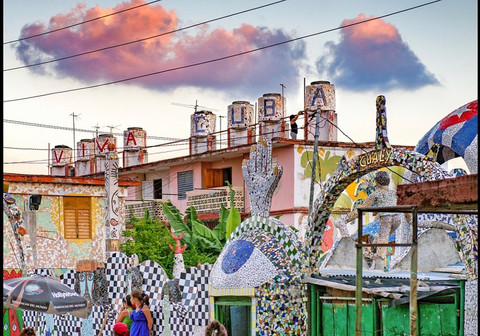José Rodríguez Fuster
- Monica Blignaut
- Jun 6, 2019
- 2 min read

Artist 136 José Rodríguez Fuster Fusterlandia Mosaic Building a town’s Identity
José Rodríguez Fuster (born 1946) is a Cuban artist specializing in ceramics, painting, drawing, engraving, and graphic design.
His unlikely canvas and the theme of today is the unassuming village of Jaimanitas only a stone’s throw from downtown Havana.
It is an architectural dreamscape that he has built over 10 years by rebuilding and decorating the fishing town of Jaimanitas in the outskirts of Havana, his home town.
Jaimanitas is now a unique work of public art where Fuster has decorated over 80 houses with ornate murals and domes to suit the personality of his neighbours, he has built a chess park with giant boards and tables, a theatre and public swimming pools.
Nowadays, Fuster’s art is a cherished part of Cuban culture and joins the rank of other famous public artworks. He sponsors this project by the sale of his paintings and ceramics.
In 1975 it began when he converted his own home into an art museum by adorning it with mosaic tiles. “I started building my dream,” he says.
His neighbours in the community were so attracted by the murals and colourful nativism that they gave up their homes to Fuster, so that he could expand the project. Before long, they began to contribute, and a new generation of artists and architects was born.
Now, although the focal centre of the project is still Fuster’s home, Taller-Estudio Jose Fuster, the whole neighbourhood is a kaleidoscope of intricate mosaics and sculpture, known as Fusterlandia.
Visitors can explore the undulating walkways and labyrinthine passages, passing under archways and examining the ceramics close-up, in this unique example of modern art and architecture.
But you can see why Fuster is known as the “Picasso of the Caribbean”, with his bold, whimsical colour and surrealist, childlike depictions.
The project is Caribbean in soul: chickens, palm trees and crocodiles dot the walls, with nods to indigenous folk history and Santeria beliefs. Of course, Cuban flags and “Viva Cuba” can be seen all over the barrio.
Almost every surface of the neighbourhood, from street signs to park benches, has been decorated – if not by Fuster, then by his neighbours, family or other Cuban talents.
Fuster himself can still be seen around the barrio, working and interacting with his neighbours or painting ceramics with his son. They work with the objective of creating the largest mural in the world.

The project stands as a stunning testament to how architecture goes beyond physical functionality, and comes to shape and be shaped by its community.
The city itself has developed an identity through his art and it has changed the lives of the people in it for the better. It’s a beautiful example of what a difference art can make













Comments